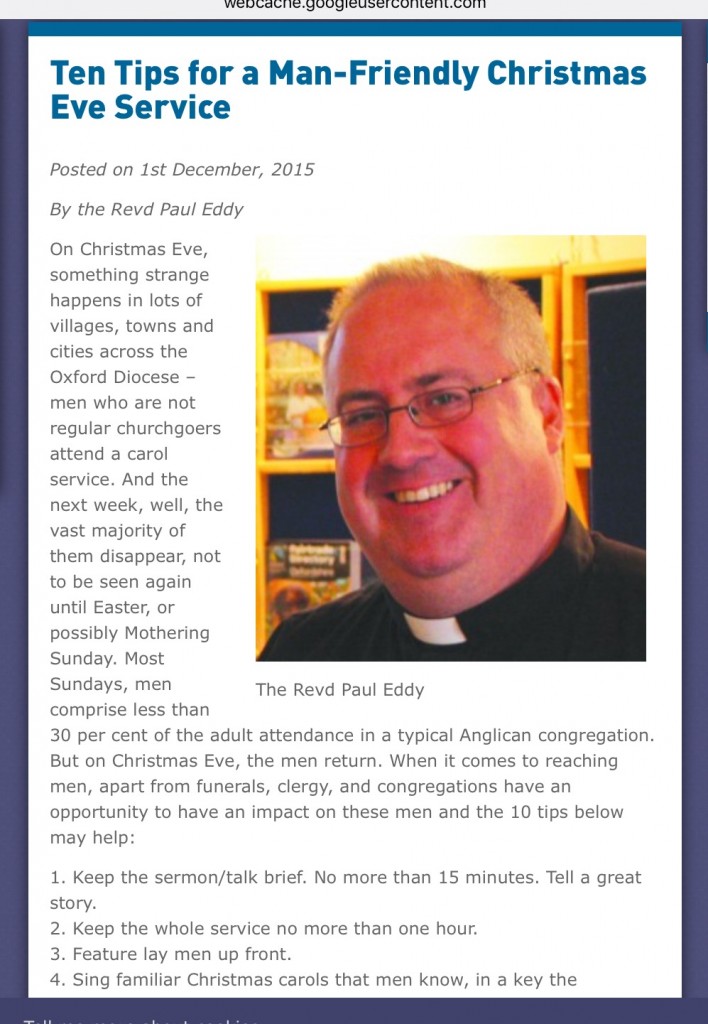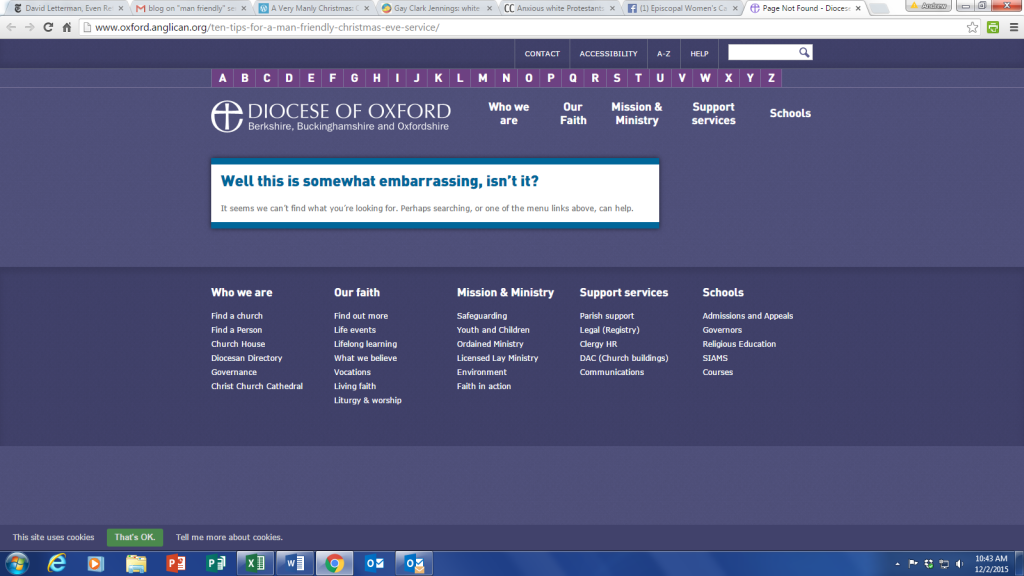Yesterday, the Diocese of Oxford in the Church of England (#nottheonion) posted a list entitled “Ten Tips for a Man-Friendly Christmas Eve Service,” bylined the Reverend Paul Eddy, who attempts to address the problem of male attendance at worship – “less than 30 per cent of the adult attendance in a typical Anglican congregation,” except when Christmas Eve rolls around, and hence the opportunity to reel them back in. He offers 10 suggestions, including:
1. Keep the sermon/talk brief. No more than 15 minutes. Tell a great story.
5. Talk about the adventure and danger of the Mission Christ had. Tell the story of a martyr.
7. Employ masculine imagery and language.
8. Play a video clip from an action film as a metaphor.
10. Present Christ the man rather than Christ the infant, and focus teaching on Christ’s power and mission, rather than just his meekness and gentleness.
Plus an extra suggestion:
Oh and one big mistake: Many churches build their Christmas Eve services around adorable little children dressed as angels. Parents crowd the stage area, snapping pictures. ‘it’s for the children,’ is the message given. Well, maybe, but it is also for mum AND dad. We need to be careful that the annual visit to church by men doesn’t perpetuate their myth that Church and faith is for women and children. This is NOT to say that some Christmas cuteness will drive men out the door – of course not. Dads also like to see their children engaged and having fun – just let’s not overdo it!
By this morning, the post had disappeared, replaced by “Well, this is embarrassing”:
…a sentiment echoed by many in the social media sphere.
Welp. Not as embarrassing as the original, shockingly sexist content. Thanks for removing it, @oxforddiocese. pic.twitter.com/wqdiRVAN3h
— Scott Gunn ن (@scottagunn) December 2, 2015
@FrPip @thurible @oxforddiocese I’m looking forward to the follow-up “How to crochet a service for women (with flowers and frills)”
— Ruth Harley (@ruth_hw) December 2, 2015
And the Diocese itself took to Twitter to explain the disappearance of the story:
@HannahCleugh@jembloomfield We took the piece down from the website due to the strength of reaction from readers.
— Diocese of Oxford (@oxforddiocese) December 2, 2015
In his blog, quiteirregular, Jem Bloomfield writes a response:
I’ve written quite often on this blog about Christianity and gender, and particularly the strands of popular Christian thought which express concern over the presence and authority of women in the British church. Being a man myself, and having only been baptised within the last few years, I’m enthusiastic about what Christianity can offer men.
But I’m also concerned by the undertones in Christian discussion of blaming women, or accommodating Christian thought and spirituality to stereotypes of masculinity. The influence of US writers and preachers like David Murrow and Mark Driscoll has a tendency to anoint corrosive gender roles as natural and ordained by God. I thought it was worth examining the suggestions provided by this article, and relating them to the ongoing discussions over gender in the church.
…including a point-by-point look at Eddy’s list:
7. Employ masculine imagery and language.
This one verges on the incredible, if it means what it seems to mean. This last year the Church of England had one of its periodic public arguments about gendered language, in which it became clear that large swathes of the church are uncomfortable referring to God as “she”. There’s a perfectly good theological rationale for that: God is not a thing in the world and has no gender, so God is not a “she” any more than God is a “he”.
However, the idea that the Christian tradition has de-emphasized masculine language is remarkable. God is referred to as Father, as Son, as King, as Lord, in the regular prayers, Bible readings and liturgies of the Church of England. The overwhelming majority of the terminology used to either name or describe God (activities that are always metaphorical) connects to male people in the world. As a man, I’ll never know what it’s like to live my spiritual life in a tradition where practically every term for the source of life and goodness and truth is identified with a different gender to me.
Jim Naughton tried his hand at writing an action story with “masculine imagery and language” on Facebook, linked here.
This is not the first time the Oxford diocese has addressed concerns over a decline in male attendance: the Cafe posted a piece from the Church Times in 2011.
The original blog post has not entirely disappeared from the internet; you can read the cached post can here.


